Early Fire Detection: A New Indoor Laboratory Dataset and Data Distribution Analysis
Abstract
:1. Introduction
2. Materials and Methods
2.1. Experimental Setup
2.2. System Architecture and Communications Flow
3. Results and Discussion
3.1. Variable Correlation Analysis
3.2. Data Distribution Analysis
4. Conclusions
Author Contributions
Funding
Institutional Review Board Statement
Informed Consent Statement
Data Availability Statement
Acknowledgments
Conflicts of Interest
Glossary
| Main Dataset | |
| Time: | Time (in 24-h format) when data was recorded by the sensor. |
| Reading ID#: | unique id for the row or instances |
| Humidity%: | humidity percentage |
| Temperature: | temperature record in Celsius (°C) |
| MQ139: | VOC gases (most sensitive to the Ammonia (NH3) and Freon gases level |
| TVOC: | TVOC (Total Volatile Organic Compounds) level |
| eCO2: | the estimated concentration of carbon dioxide calculated from known TVOC concentration. This assumes that the VOC produced by humans is proportional to their exhaled CO2. The analog output of the VOC sensor is in the range of 400–2000 ppm eCO2. |
| Detector: | the fire alarm detection (conventional Photoelectric smoke detector). ‘OFF’ indicates no fire detected, while ‘OFF’ indicates a fire is detected |
| Status: | ‘0’ represents the initial point of the experiment (i.e., no fire or activated alarm). ‘1’ represents the point at which the fire has been started but with no activated alarm yet (i.e., by electrical devices or charcoal). ‘2’ represents the point at which the real fire system was activated by the fire cause. |
References
- Kumar, A.; Gaur, A.; Singh, A.; Kumar, K.S.; Kulkarni, S.; Lala, K.; Kapoor, V.; Srivastava, S.C. Mukhopadhyay, Fire sensing technologies: A review. IEEE Sens. J. 2019, 19, 3191–3202. [Google Scholar] [CrossRef]
- Fernández-Alaiz, F.; Castañón, A.M.; Gómez-Fernández, F.; Bernardo-Sánchez, A.; Bascompta, M. Determination and Fire Analysis of Gob Characteristics Using CFD. Energies 2020, 13, 5274. [Google Scholar] [CrossRef]
- Maragkos, G.; Beji, T. Review of Convective Heat Transfer Modelling in CFD Simulations of Fire-Driven Flows. Appl. Sci. 2021, 11, 5240. [Google Scholar] [CrossRef]
- Kolaitis, D.; Asimakopoulou, E.; Founti, M. CFD Simulation of Fire Spreading in a Residential Building: The Effect of Implementing Phase Changing Materials. In Proceedings of the 5th European Combustion Meeting, Cardiff, UK, 30 June–2 July 2011. [Google Scholar]
- Sesseng, C. Mapping of Gas Concentrations, Effect of Deadair Space and Effect of Alternative Detection Technology in Smouldering Fires. SPFR Rep. A 2016, 16, 20053. [Google Scholar]
- Fonollosa, J.; Solórzano, A.; Marco, S. Chemical sensor systems and associated algorithms for fire detection: A review. Sensors 2018, 18, 553. [Google Scholar] [CrossRef] [Green Version]
- Solórzano, A.; Fonollosa, J.; Marco, S. Improving Calibration of Chemical Gas Sensors for Fire Detection Using Small Scale Setups. Proceedings 2017, 1, 453. [Google Scholar] [CrossRef] [Green Version]
- Fleming, J.M. Smoke Detector Technology and the Investigation of Fatal Fires May 2000; Boston Fire Department: Boston, MA, USA, 2000. [Google Scholar]
- Andrew, A.M.; Shakaff, A.Y.M.; Zakaria, A.; Gunasagaran, R.; Kanagaraj, E.; Saad, S.M. Early stage fire source classification in building using artificial intelligence. In Proceedings of the 2018 IEEE Conference on Systems, Process and Control (ICSPC 2018), Melaka, Malaysia, 14–15 December 2018; pp. 165–169. [Google Scholar] [CrossRef]
- Wu, L.; Chen, L.; Hao, X. Multi-Sensor Data Fusion Algorithm for Indoor Fire Early Warning Based on BP Neural Network. Information 2021, 12, 59. [Google Scholar] [CrossRef]
- Maheen, J.B.; Aneesh, R.P. Machine learning algorithm for fire detection using color correlogram. In Proceedings of the 2019 2nd international conference on intelligent computing, instrumentation and control technologies (ICICICT), Kannur, India, 5–6 July 2019; Volume 1. [Google Scholar]
- Khan, R.A.; Uddin, J.; Corraya, S.; Kim, J. Machine vision based indoor fire detection using static and dynamic features. Int. J. Control. Autom. 2018, 11, 87–98. [Google Scholar]
- Saponara, S.; Elhanashi, A.; Gagliardi, A. Real-time video fire/smoke detection based on CNN in antifire surveillance systems. J. Real-Time Image Processing 2020, 18, 889–900. [Google Scholar] [CrossRef]
- Li, P.; Zhao, W. Image fire detection algorithms based on convolutional neural networks. Case Stud. Therm. Eng. 2020, 19, 100625. [Google Scholar] [CrossRef]
- Bukowski, R.; Peacock, R.D.; Averill, J.; Cleary, T.; Bryner, N.; Walton, W.; Reneke, P.A.; Kuligowski, E.D. Performance of Home Smoke Alarms, Analysis of the Response of Several Available Technologies in Residential Fire Settings; National Institute of Standards and Technology: Gaithersburg, MD, USA, 2008.
- Chagger, R.; Smith, D. The Causes of False Fire Alarms in Buildings; Briefing Paper; BRE Global Limited: Watford, UK, 2014. [Google Scholar]
- Augustin, A.; Yi, J.; Clausen, T.; Townsley, W.M. A Study of LoRa: Long Range & Low Power Networks for the Internet of Things. Sensors 2016, 16, 1466. [Google Scholar] [CrossRef]
- Chaudhari, B.S.; Zennaro, M.; Borkar, S. LPWAN Technologies: Emerging Application Characteristics, Requirements, and Design Considerations. Future Internet 2020, 12, 46. [Google Scholar] [CrossRef] [Green Version]
- LoRa Alliance. LoRaWAN v1.0 Specification; LoRa Alliance: Fremont, CA, USA, 2015; Available online: https://lora-alliance.org/resource-hub/lorawanr-specification-v10 (accessed on 24 November 2021).
- Janssen, T.; BniLam, N.; Aernouts, M.; Berkvens, R.; Weyn, M. LoRa 2.4 GHz Communication Link and Range. Sensors 2020, 20, 4366. [Google Scholar] [CrossRef] [PubMed]
- Saputra, F.A.; Rasyid, M.U.H.A.; Abiantoro, B.A. Prototype of early fire detection system for home monitoring based on Wireless Sensor Network. In Proceedings of the 2017 International Electronics Symposium on Engineering Technology and Applications (IES-ETA), Surabaya, Indonesia, 26–27 September 2017; pp. 39–44. [Google Scholar] [CrossRef]
- Al Rasyid, M.U.H.; Enda, D.; Saputra, F.A. Smart Home System for Fire Detection Monitoring Based on Wireless Sensor Network. In Proceedings of the 2019 International Electronics Symposium (IES), Surabaya, Indonesia, 18 November 2019; pp. 189–194. [Google Scholar] [CrossRef]
- Vijayalakshmi, S.R.; Muruganand, S. A survey of Internet of Things in fire detection and fire industries. In Proceedings of the 2017 International Conference on I-SMAC (IoT in Social, Mobile, Analytics and Cloud) (I-SMAC), Palladam, India, 10–11 February 2017; pp. 703–707. [Google Scholar] [CrossRef]
- Sendra, S.; García, L.; Lloret, J.; Bosch, I.; Vega-Rodríguez, R. LoRaWAN Network for Fire Monitoring in Rural Environments. Electronics 2020, 9, 531. [Google Scholar] [CrossRef] [Green Version]
- Adnan; Salam, A.E.U.; Arifin, A.; Rizal, M. Forest Fire Detection using LoRa Wireless Mesh Topology. In Proceedings of the 2018 2nd East Indonesia Conference on Computer and Information Technology (EIConCIT), Makassar, Indonesia, 6–7 November 2018; pp. 184–187. [Google Scholar] [CrossRef]
- Available online: https://www.parallax.com/package/plx-daq (accessed on 24 November 2021).
- Available online: https://theclimatecenter.org/resources/glossary/ (accessed on 24 November 2021).
- Stec, A.A. Fire toxicity–the elephant in the room? Fire Saf. J. 2017, 91, 79–90. [Google Scholar] [CrossRef]
- Available online: https://dotnet.microsoft.com/apps/xamarin (accessed on 24 November 2021).
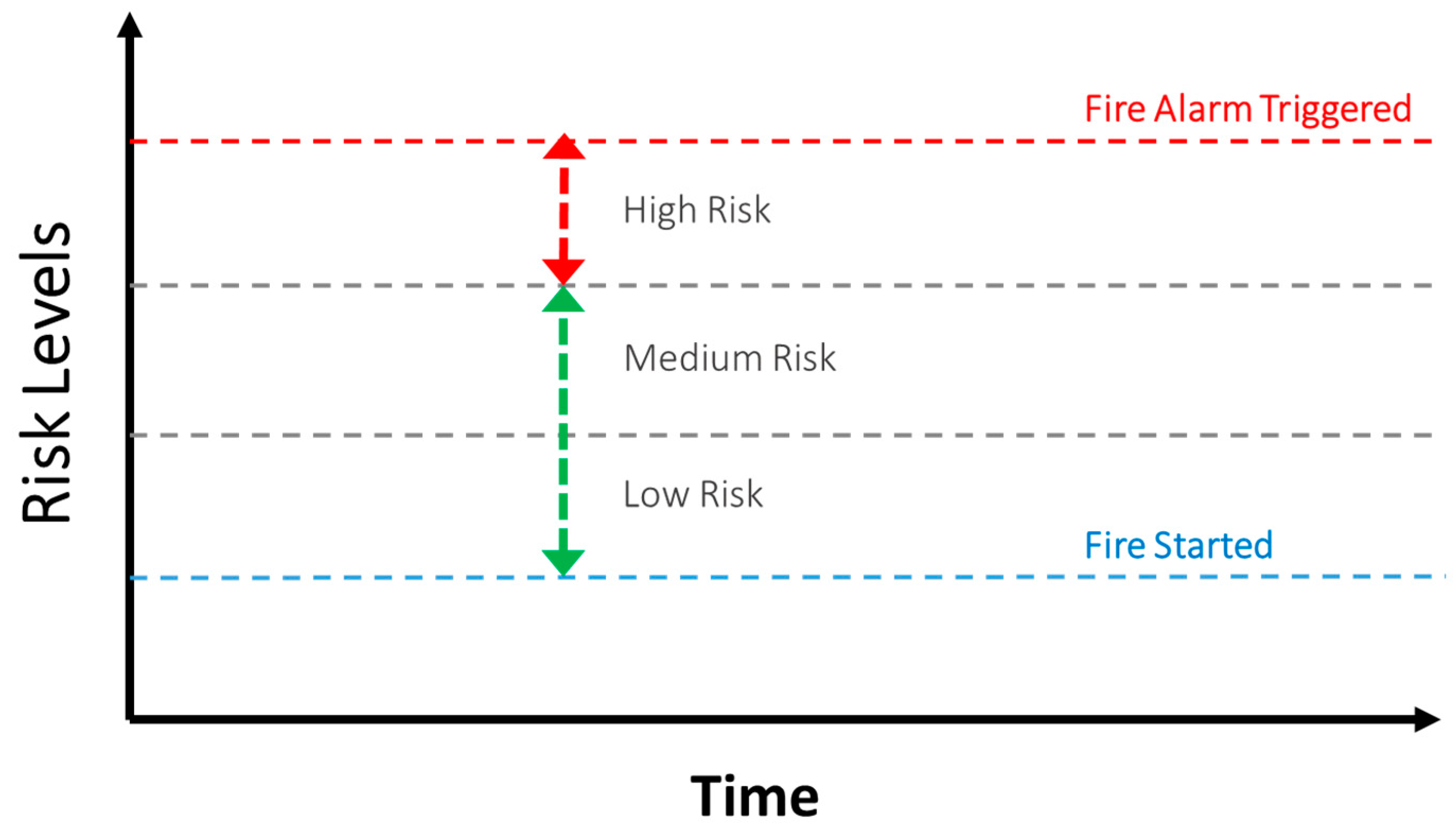
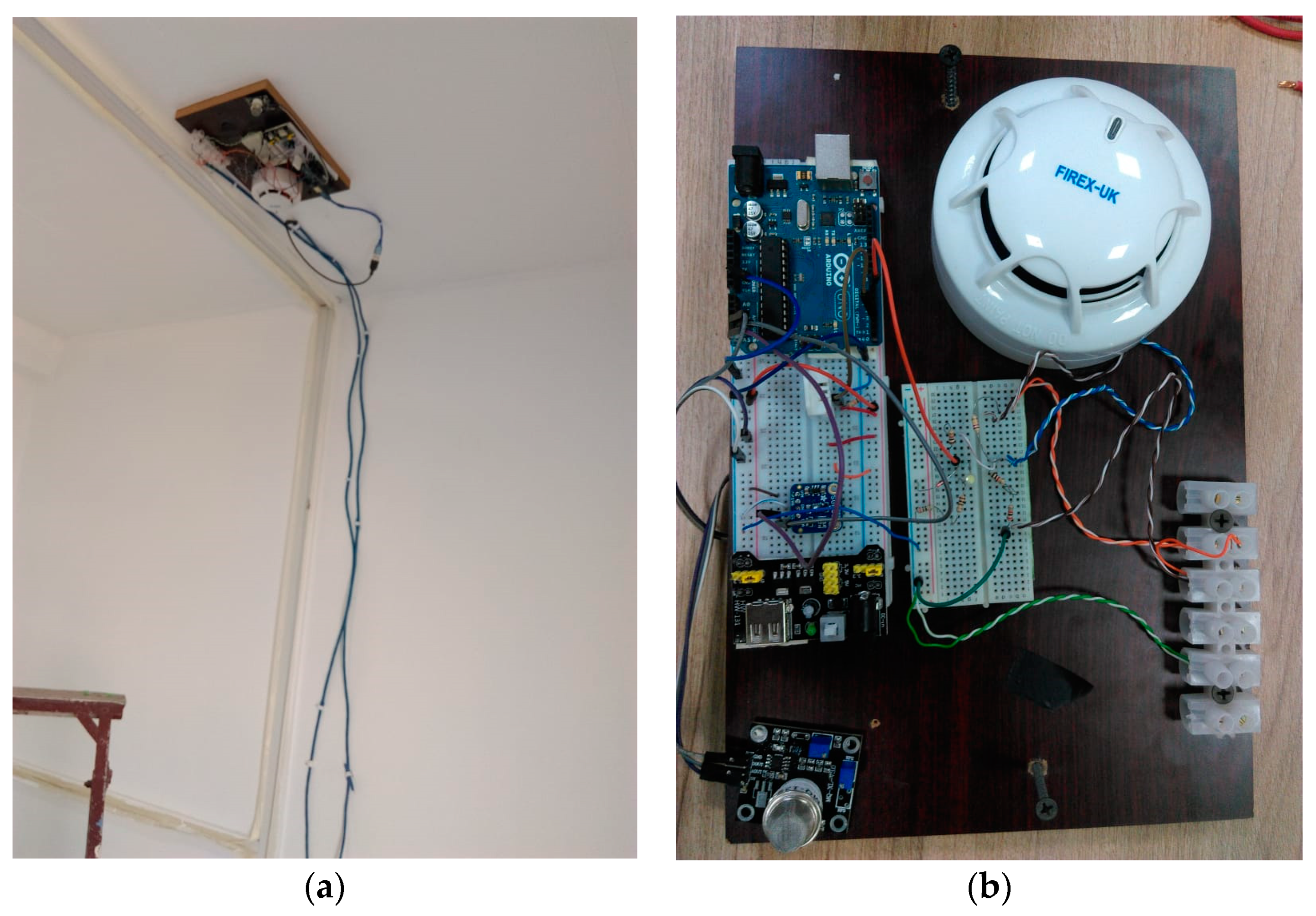
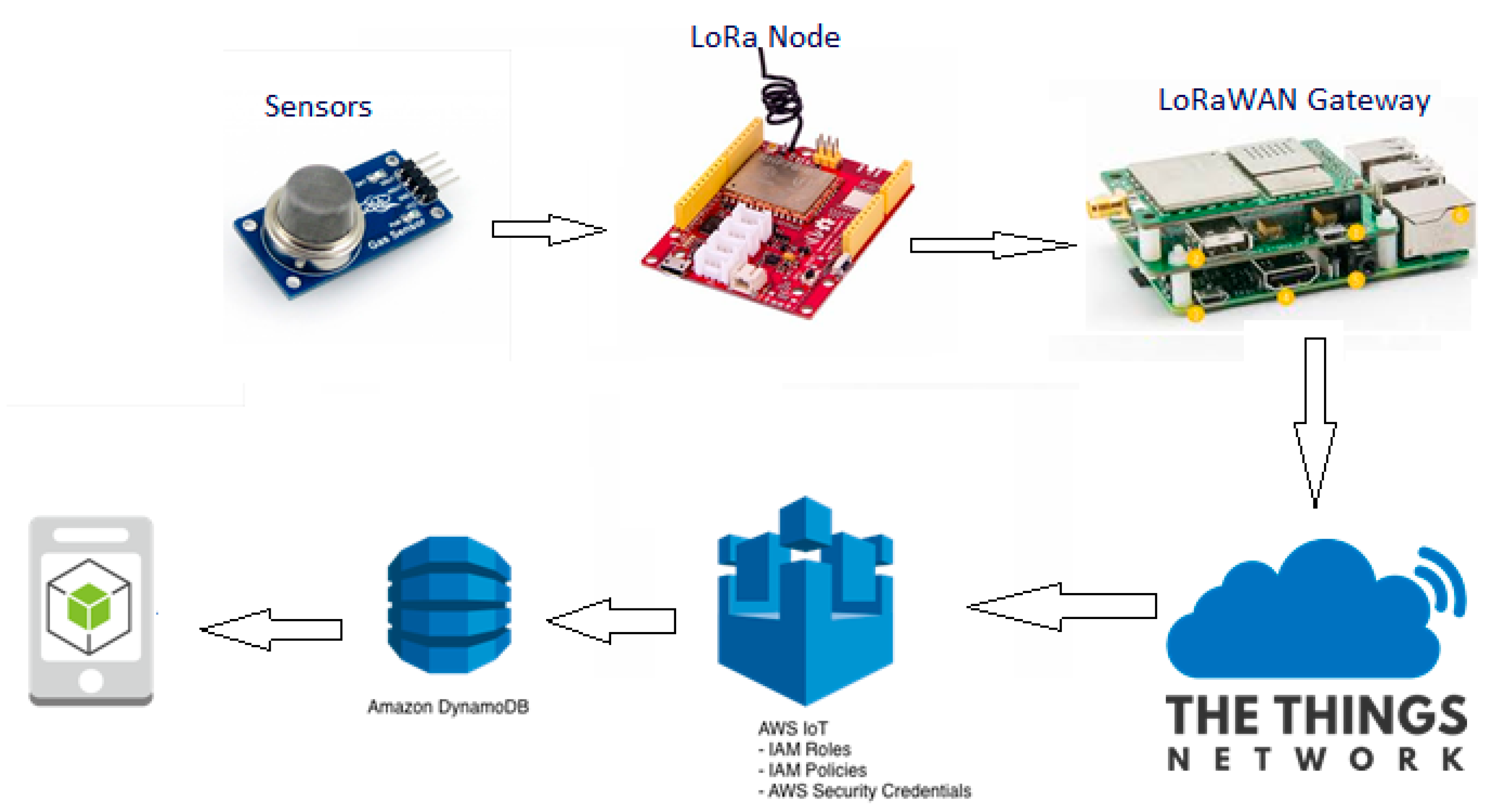
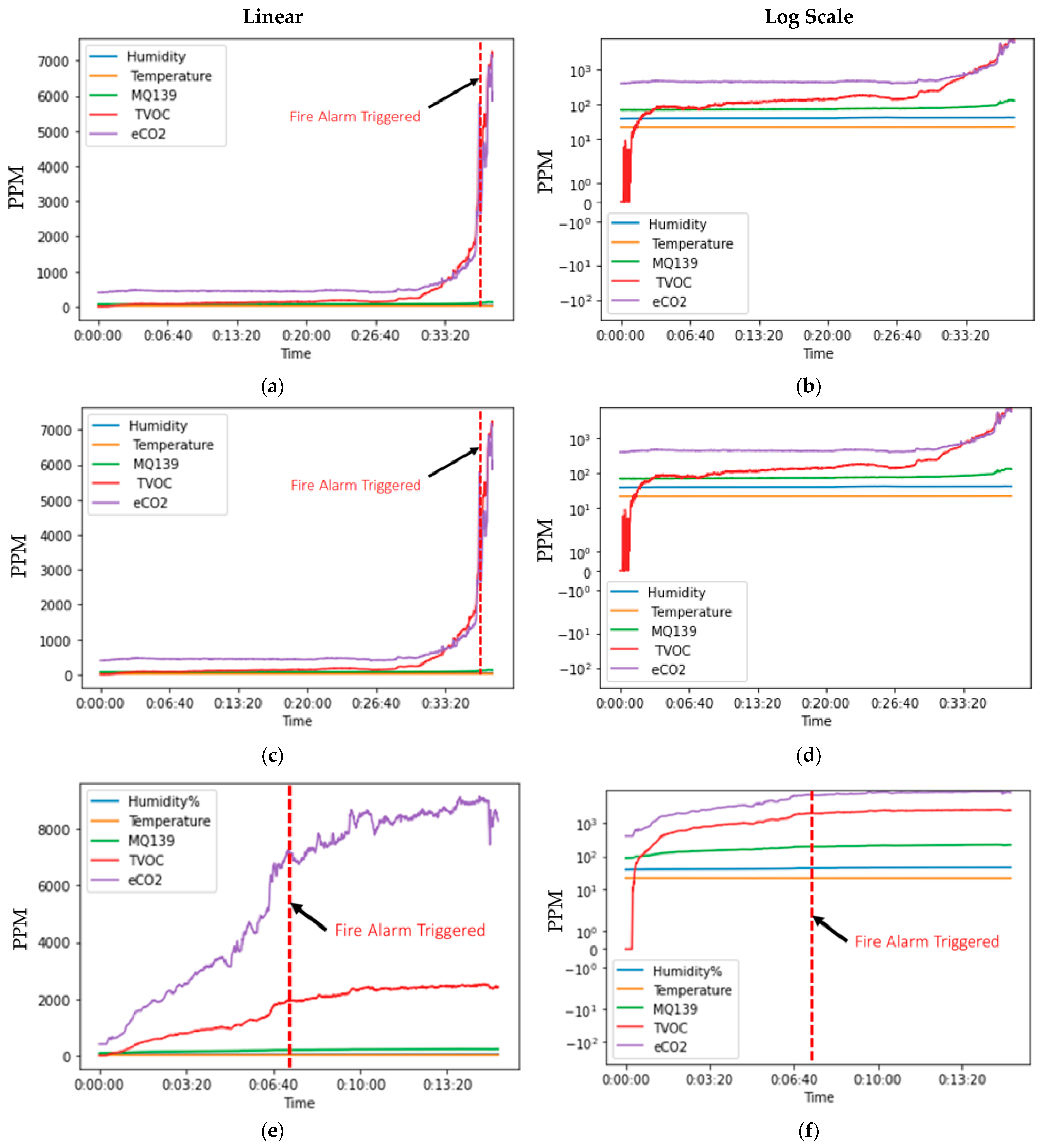
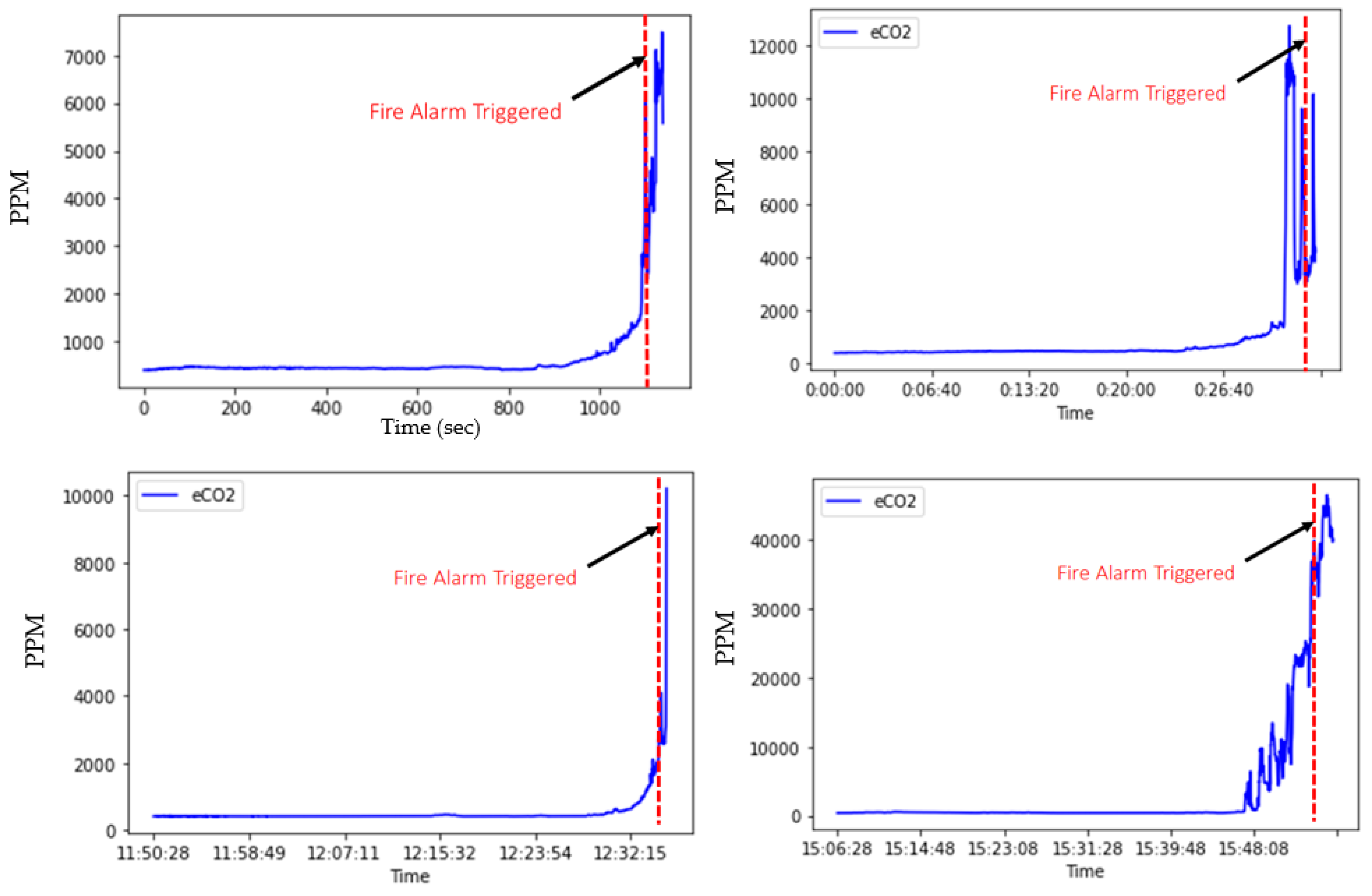

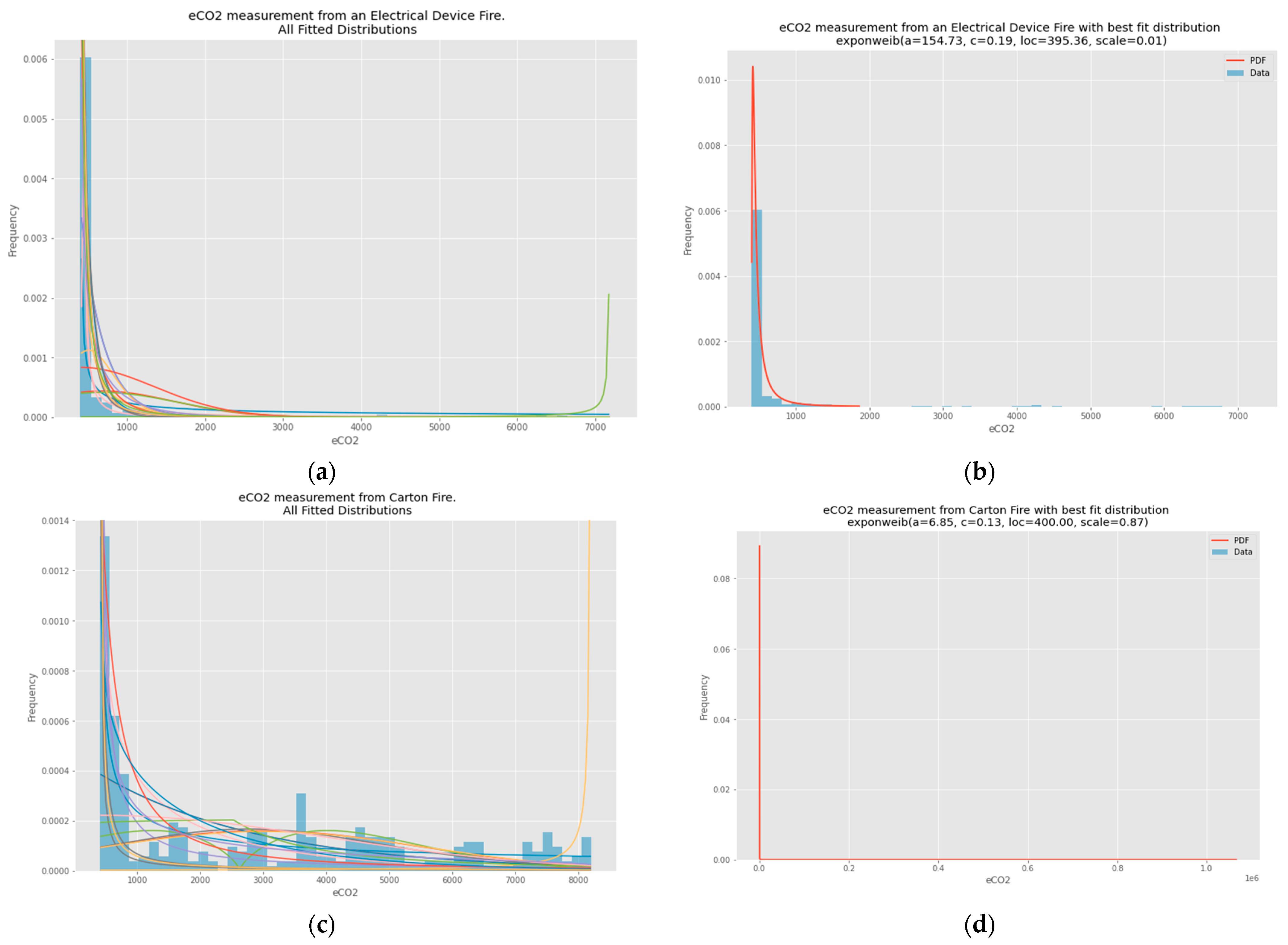

| Title 1 | Title 2 | Title 3 |
|---|---|---|
| Electrical/Clothes | Experiment 1 | 37 min 58 s |
| Experiment 2 | 33 min | |
| Experiment 3 | 12 min 35 s | |
| Experiment 4 | 15 min 56 s | |
| Charcoal/Clothes | Experiment 1 | 15 min 6 s |
| Experiment 2 | 17 min 7 s | |
| Charcoal/Cardboard Paperboard | Experiment 1 | 14 min 12 s |
| Experiment 2 | 17 min 31 s |
| Source of Fire | Measurement | Best Fitted Distribution | Sum of Square Errors (SSEs) |
|---|---|---|---|
| Electrical/Cloth | eCO2 | Exponentiated Weibull Distribution | 0.00011267029929785147 |
| TVOC | Double Weibull Distribution | 2.708889556679 × 10−5 | |
| Humidity | Double Weibull Distribution | 366.03915174693213 | |
| Temperature | Double Weibull Distribution | 38157.55591746159 | |
| MQ139 | Power Lognormal Distribution | 0.5513364247530835 | |
| Charcoal/cardboard | eCO2 | Exponentiated Weibull Distribution | 6.986666475369561 × 10−6 |
| TVOC | Exponentiated Weibull Distribution | 1.4865994920838973 × 10−5 | |
| Humidity | Beta Distribution | 1236.9933162581392 | |
| Temperature | Beta Distribution | 103053.45783803816 | |
| MQ139 | Power Law Distribution | 0.10289974506654861 | |
| Charcoal/Clothing | eCO2 | Log Gamma Distribution | 2.788708658959186 × 10−6 |
| TVOC | Log Gamma Distribution | 3.8246971469792034 × 10−5 | |
| Humidity | Log Gamma Distribution | 29.494137424567498 | |
| Temperature | Double Weibull Distribution | 44790.0445294828 | |
| MQ139 | Pearson type (PT) III distribution | 0.02046073738554408 |
Publisher’s Note: MDPI stays neutral with regard to jurisdictional claims in published maps and institutional affiliations. |
© 2022 by the authors. Licensee MDPI, Basel, Switzerland. This article is an open access article distributed under the terms and conditions of the Creative Commons Attribution (CC BY) license (https://creativecommons.org/licenses/by/4.0/).
Share and Cite
Nazir, A.; Mosleh, H.; Takruri, M.; Jallad, A.-H.; Alhebsi, H. Early Fire Detection: A New Indoor Laboratory Dataset and Data Distribution Analysis. Fire 2022, 5, 11. https://doi.org/10.3390/fire5010011
Nazir A, Mosleh H, Takruri M, Jallad A-H, Alhebsi H. Early Fire Detection: A New Indoor Laboratory Dataset and Data Distribution Analysis. Fire. 2022; 5(1):11. https://doi.org/10.3390/fire5010011
Chicago/Turabian StyleNazir, Amril, Husam Mosleh, Maen Takruri, Abdul-Halim Jallad, and Hamad Alhebsi. 2022. "Early Fire Detection: A New Indoor Laboratory Dataset and Data Distribution Analysis" Fire 5, no. 1: 11. https://doi.org/10.3390/fire5010011






